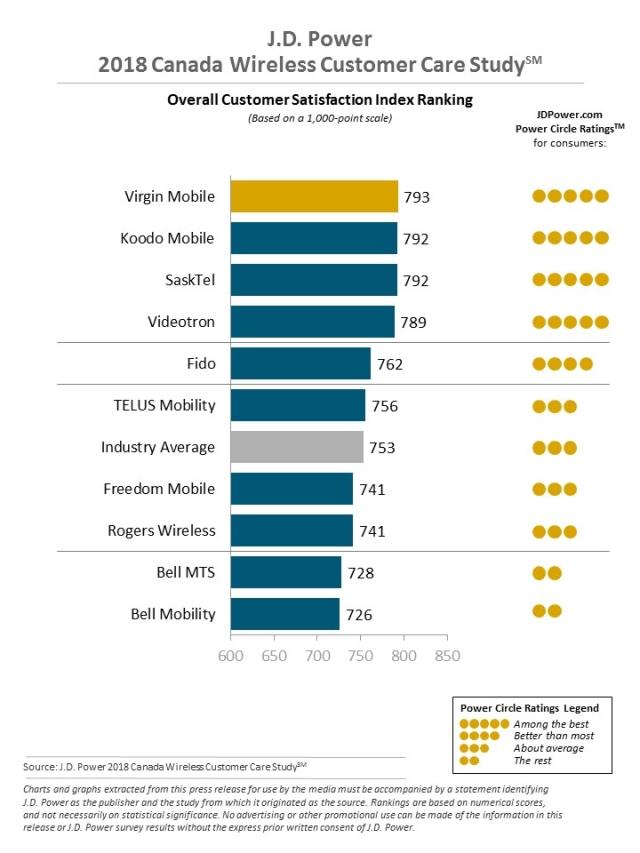Streamlined Issue Resolution a Key to Reducing Wireless Carriers’ Churn, J.D. Power Finds
Virgin Mobile Ranks Highest in Customer Care Satisfaction for Second Consecutive Year
TORONTO: 26 April 2018 —Canada’s wireless providers should take note of the effect their issue-resolution processes have on customer retention. According to the J.D. Power 2018 Canada Wireless Customer Care Study,SM released today, 32% of customers indicate that it took a lot of effort to resolve a recent problem with their wireless carrier, while 41% who encountered hurdles in the resolution process are considering—or have decided—to switch their provider.
The study shows that the amount of effort required from a customer to resolve an issue significantly affects their satisfaction with, and impression of, their provider. Overall satisfaction among customers who faced challenges dealing with their wireless provider is 186 points lower (on a 1,000-point scale) than among those who had a seamless experience (652 vs. 838, respectively). Furthermore, customers who experienced an onerous problem-solving process viewed their wireless provider less favorably, perceiving the carrier to be more focused on the bottom line than customer service, unreliable and providing poor value.
“Without a doubt, a seamless customer care experience can positively affect a consumer’s view of their wireless provider and appetite to remain a loyal customer,” said Adrian Chung, Director of the Technology, Media & Telecom Practice at J.D. Power in Canada. “It is no secret that retaining customers is more cost-effective than acquiring new ones. Therefore, Canadian carriers should put a greater emphasis on streamlining the customer care experience and making it as effortless as possible. They should also be extra conscious about utilizing the appropriate contact channels.”
Nearly two-thirds (62%) of customers used their phone as a channel to resolve an issue with their wireless service provider in the past six months. While a phone call is still the most common channel among customers, the use of social media as an option for problem solving is on the rise, especially among younger customers. Nearly one-fourth (23%) of Gen Z[1] wireless customers have used social media to post a question, compared with only 4% of Boomers. Similarly, 24% of Gen Z customers—but only 7% of Boomers—have researched social media for an answer.
“With generational shifts, social media’s role as a preferred channel for problem resolution continues to grow, but the study shows that wireless carriers are not fully able to handle the task yet,” Chung said. “Customers who do their own research on social media platforms are able to solve issues faster than those who post a question and have to wait for answers.”
Posting on social media to resolve an issue results in lower satisfaction levels (696), compared with using social media to independently research a problem (765). Among the unassisted channels, watching a carrier video increases satisfaction (769), compared with the unassisted care average (718).
Following are additional key findings of the 2018 study:
- The virtual hold keeps customers on hold: Customers who called for assistance and opted for a virtual hold waited 59 minutes, on average, for a call back, compared to the 12 minutes it took customers who waited on hold to speak to a representative. Virtual holds drag down satisfaction with the phone channel, which is 47 points lower than when not using virtual hold (719 vs. 766, respectively).
- Talking to a manager doesn’t guarantee resolution: Customers who phoned their wireless carrier with an issue that was escalated to a manager were less satisfied with their phone channel experience, compared with industry average (650 vs. 757, respectively). Also, only 73% of such customers were likely to resolve the issue, compared with the industry average of 83%.
Study Rankings
Virgin Mobile ranks highest in overall customer care satisfaction for the second consecutive year, with a score of 793. Koodo Mobile and SaskTel rank second in a tie with a score of 792. Videotron follows with a score of 789. The overall satisfaction average is 753.
The 2018 Canada Wireless Customer Care Study measures wireless customers’ perceptions of their carrier’s performance. Satisfaction is measured in two factors: assisted care and unassisted care. The assisted care channels include: phone customer service representative (CSR); in-store; online chat; email; post to social media; and carrier’s mobile app to ask a question or make a request. The unassisted care channels include: automated telephone system (ARS); website to look for information; social media site to look for information; and user forums.
The study was fielded in February-March 2018 and is based on an online survey of more than 5,000 wireless customers. Respondents are residents of Canada with a postpaid wireless service who had a customer service experience in the past six months.
J.D. Power is a global leader in consumer insights, advisory services and data and analytics. These capabilities enable J.D. Power to help its clients drive customer satisfaction, growth and profitability. Established in 1968, J.D. Power is headquartered in Costa Mesa, Calif., and has offices serving North/South America, Asia Pacific and Europe. J.D. Power is a portfolio company of XIO Group, a global alternative investments and private equity firm headquartered in London, and is led by its four founders: Athene Li, Joseph Pacini, Murphy Qiao and Carsten Geyer.
Media Relations Contacts
Gal Wilder, Cohn & Wolfe; Toronto, Canada; 647-259-3261, gal.wilder@cohnwolfe.ca
Stephanie Ronson, Cohn & Wolfe; Toronto, Canada; 647-259-3278, stephanie.ronson@cohnwolfe.ca
Geno Effler; J.D. Power; Costa Mesa, Calif.; 714-621-6224; media.relations@jdpa.com
About J.D. Power and Advertising/Promotional Rules www.jdpower.com/business/about-us/press-release-info
[1] J.D. Power defines generational groups as Pre-Boomers (born before 1946); Boomers (1946-1964); Gen X (1965-1976); Gen Y (1977-1994) and Gen Z (1995 or later). Xennials (1978-1981) and Millennials (1982-1994) are subsets of Gen Y.
